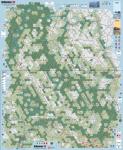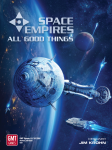![]()
![]()
![]()
![]()
![]()
![]()
Expansion or Extinction
A Triumph & Tragedy Series Game
Expansion or Extinction takes 2 to 4 players into a future where Sol, after colonizing many of the closest stars, succumbed to internal pressures and died in a fiery holocaust of future weaponry. Now earth’s colonies are recovering, and beginning to exert their own dominance on the stars around them. Based on the award-winning Triumph and Tragedy game system, Expansion or Extinction expands upon this proven and highly popular game system.
Expansion or Extinction begins as each of the player’s star systems have rediscovered the technologies which make space travel possible again. Players must explore the systems around them, and attempt to bring them into their sphere of influence. This can occur either peaceably through the play of Action Cards, or through military conquest.
There are three types of star systems in Expansion or Extinction. Those closest to SOL: the Core Worlds. These worlds have been settled the longest, and thus tend to have the highest population, but have consumed most of their resources. Those furthest out: the Outer Rim worlds, which were settled just before SOL’s fall. These tend to have low population but high resources. And between those extremes are the Green Worlds…where the players start, here there is a good balance of population and resources. But beware, these worlds are on the cusp of challenging for dominance on their own, and have the fleets to make their conquest a hard fought struggle!
Much like its predecessor, there are multiple paths to victory.
- Economic Hegemony (where the total of Production + secret Peace Dividend values is the greatest at the end of the game, or reaches 30 at any time) OR
- Technological Supremacy (the first player to build the Death Star — which takes 4 stages) OR
- Military Victory (control of THREE Green Worlds – there are six and each player starts on one).
Like its predecessor, many of the mechanics of the game are the same. There is an Action Deck and an Investment Deck, a vault to hide your technologies, a government phase and action phases, peace dividends, hand size restrictions and blockading.
So how is Expansion or Extinction different from Triumph and Tragedy?
The Draft. After setting up, players go through a draft which alters a player’s base starting characteristics. Each player will modify up to 8 different attributes of their starting position…giving every game a unique start! There are 11 possible modifying categories, with multiple cards in each category….do you keep that +1 Pop card or pass it to your neighbor hoping for a +2 Pop? Various categories include: starting Pop, starting Industry, starting Factories and Factory Cost to name just a few. The hard decisions begin immediately!
The Set-up. Each player will start controlling one “green” system. In each system a player will place a 3 step outer fort, a 4 step inner fort and one full strength block of each combat unit.
Systems. Systems have both an outer system and a planetary surface. Outer Systems is where combat between fleets occurs, and there is no limit to the number of rounds of combat. Planetary combat is limited to one round of combat, and is restricted to planetary units.
Units. There are 3 classes of units, Naval, Fighter and Planetary. The Naval class units include: Outer System Fortresses, Battleships, Destroyers(DD) and Convoys (planetary class units moving to another system). The Fighter Class which includes Carriers (CV) and Fighters. Third are the Planetary Class units, these include: Planetary Fortresses, Space Marines, Infantry and Rebels .
Exploring. Before a player can influence a system (or send units other than DD’s to it), that system must be explored. Exploration can occur in one of three ways. First, during the draft, one of the categories allows player to explore 1, 2 or 3 of the closest systems. Secondly, players may play an action card which lists that system to explore it. Third, players may send DD’s to physically explore a system, when a DD enters an unexplored system the owning player rolls a dice to determine whether or not the DD was successful. The stronger the DD, the more likely it will be successful! Bonus, the first player to explore all of the systems on the map earns a bonus of 3 Peace Dividends.
Economics. In EOE not everything costs the same! Fortresses, BB, CV and Space Marines all cost 1 production point per step, while DD, Fighters and Infantry all cost ½ (i.e. you get two steps of Infantry for every production point you spend on Infantry). In order to have a step added to a unit, it must be at a friendly controlled system. Home World bonus: Units located at a players home world, or being built there may have 2 steps added to them!
Rebels. Once a system allies with an enemy player, it is no longer possible to diplomatically influence that system. As more systems become controlled by players, Action Cards now take on an added power, placing Rebels. Rebels are generally a weak unit, but they have a special power, the surprise attack (this attack takes place before the combat round and the owning player targets the hits!). Players can no longer afford to neglect their rear areas…because if they do, they might find themselves losing systems to rebel units!
Movement. DD’s move 2, while all other units move one. This movement rate can be modified by gaining the appropriate technology. Units may move up to four hexes between friendly systems (Star Gates).
Expansion or Extinction is an exciting evolution of a revolutionary game design. We're taking the best aspects of a great system design and expanding upon them.
Experienced players can play a 3 person game in under 3 hours.
Game Components:
- 1 Backprinted Mounted Mapboard
- 244 Blocks
- 55 Card Action Deck
- 55 Card Investment Deck
- 416 Counters/Markers/Chits
- Rule Book
- 4 Player Aids
- 4 Player Production Sheets
- Dice
Designer: Stuart Pierce
Triumph & Tragedy System Design: Craig Besinque
| Publisher | GMT Games |
|---|
 Did you forget your password?
Did you forget your password?










